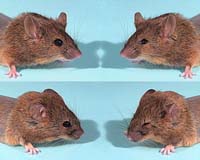 |
Santa Cruz CA (SPX) Jan 11, 2011 Researchers at the University of California, Santa Cruz, have identified a key molecule for establishing blood stem cells in their niche within the bone marrow. The findings, reported in the January issue of Cell Stem Cell, may lead to improvements in the safety and efficiency of bone marrow transplants. Bone marrow transplants are a type of stem cell therapy used to treat cancers such as lymphoma and leukemia and other blood-related diseases. In a bone marrow transplant, the "active ingredients" are hematopoietic stem cells, which live in the bone marrow and give rise to all the different kinds of mature blood cells. The new study shows that hematopoietic stem cells use a molecule called Robo4 to anchor themselves in the bone marrow. "Robo4 is a rare molecule that is found only in hematopoietic stem cells and in the endothelial cells of blood vessels," said Camilla Forsberg, an assistant professor of biomolecular engineering in the Baskin School of Engineering at UC Santa Cruz. After earlier work in her lab showed that Robo4 is specific for hematopoietic stem cells, Forsberg set out to discover how it functions. The discovery that the cells need Robo4 to stay in the bone marrow has potential therapeutic implications. An increasingly common alternative to traditional bone marrow transplants (which require anesthesia for the bone marrow extraction) involves harvesting hematopoietic stem cells from the blood. Repeated injections of drugs are needed to get the stem cells to leave the bone marrow and enter the bloodstream so that they can be collected with a blood draw. A drug that blocks Robo4 could be a safer and more effective way to do this, Forsberg said. "If we can get specific and efficient inhibition of Robo4, we might be able to mobilize the hematopoietic stem cells to the blood more efficiently," she said. "We're already working on that in the second phase of the project." Robo4 acts as an adhesion molecule, interacting with other components of the bone marrow to bind the stem cells into their proper niche. Forsberg's lab is trying to find out what molecules bind to Robo4, which could lead to a better understanding of that niche. While other types of stem cells are routinely grown in petri dishes, hematopoietic stem cells are very difficult to grow in the lab. They seem to require the bone marrow environment to function properly, and Forsberg's research might enable researchers to recreate that environment in a petri dish. Other molecules besides Robo4 are also known to be involved in guiding the localization of hematopoietic stem cells in the bone marrow. Forsberg's results indicate that one of these, called Cxcr4, acts together with Robo4 to retain hematopoietic stem cells in the bone marrow. But the two molecules appear to act through different molecular mechanisms. Inhibition of both molecules may be the best way to achieve efficient mobilization of hematopoietic stem cells, Forsberg said. Stephanie Smith-Berdan, a research specialist in Forsberg's lab, is first author of the new paper. Coauthors include UCSC researchers Andrew Nguyen, Deena Hassanein, Matthew Zimmer, Fernando Ugarte, and Lindsay Hinck, professor of molecular, cell and developmental biology; Dean Li of the University of Utah; and Jesus Ciriza and Marcos Garcia-Ojeida of UC Merced. This work was funded by UCSC and the California Institute for Regenerative Medicine.
Share This Article With Planet Earth
Related Links University of California - Santa Cruz The Clone Age - Cloning, Stem Cells, Space Medicine
 US scientists create mice from two fathers
US scientists create mice from two fathersWashington (AFP) Dec 8, 2010 US scientists have used stem cell technology to create mice from two fathers, an advance that they say could help preserve endangered species and even help same-sex couples have their own genetic children one day. According to the study published Wednesday in the journal Biology of Reproduction, reproductive scientists in Texas were able to manipulate cells from a male (XY) mouse fetus to pr ... read more |
|
| The content herein, unless otherwise known to be public domain, are Copyright 1995-2010 - SpaceDaily. AFP and UPI Wire Stories are copyright Agence France-Presse and United Press International. ESA Portal Reports are copyright European Space Agency. All NASA sourced material is public domain. Additional copyrights may apply in whole or part to other bona fide parties. Advertising does not imply endorsement,agreement or approval of any opinions, statements or information provided by SpaceDaily on any Web page published or hosted by SpaceDaily. Privacy Statement |